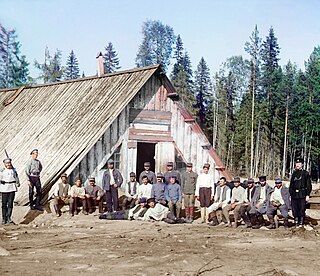
A prisoner of war (POW) is a non-combatant—whether a military member, an irregular military fighter, or a civilian—who is held captive by a belligerent power during or immediately after an armed conflict. The earliest recorded usage of the phrase "prisoner of war" dates back to 1610.

Aliyah Bet was the code name given to illegal immigration by Jews, most of whom were refugees escaping from Nazi Germany, and later Holocaust survivors, to Mandatory Palestine between 1920 and 1948, in violation of the restrictions laid out in the British White Paper of 1939, which dramatically increased between 1939 and 1948. With the establishment of the State of Israel in May 1948, Jewish displaced persons and refugees from Europe began streaming into the new sovereign state.

The Atlit detainee camp was a concentration camp established by the authorities of the British Mandate for Palestine at the end of the 1930s on the coastal plain, 20 kilometers (12 mi) south of Haifa. The camp was established by the authorities of Mandatory Palestine for the detention of Arab and Jewish Palestinian convicts in administrative detention, and for Jewish immigrants without official entry permit. Tens of thousands of Jewish refugees were interned at the camp, which was surrounded by barbed wire and watchtowers.

Exodus is a 1960 American epic historical drama film on the founding of the State of Israel. It was made by Alpha and Carlyle Productions and distributed by United Artists. Produced and directed by Otto Preminger, the film was based on the 1958 novel Exodus by Leon Uris. The screenplay was written by Dalton Trumbo. The film features an ensemble cast, and its celebrated soundtrack music was written by Ernest Gold.

Displaced persons camps in post–World War II Europe were established in Germany, Austria, and Italy, primarily for refugees from Eastern Europe and for the former inmates of the Nazi German concentration camps. A "displaced persons camp" is a temporary facility for displaced persons, whether refugees or internally displaced persons. Two years after the end of World War II in Europe, some 850,000 people lived in displaced persons camps across Europe, among them Armenians, Poles, Latvians, Lithuanians, Estonians, Yugoslavs, Jews, Greeks, Russians, Ukrainians, Hungarians and Czechoslovaks.
Administrative detention is arrest and detention of individuals by the state without trial, usually for security reasons. Many countries use administrative detention as a means to combat terrorism or rebellion, to control illegal immigration, or to otherwise protect the ruling regime.

Cyprus internment camps were camps run by the British government for internment of Jews who had immigrated or attempted to immigrate to Mandatory Palestine in violation of British policy. There were a total of 12 camps, which operated from August 1946 to January 1949, and in total held 53,510 internees.

The history of the Jews in Cyprus dates back at least to the 2nd century BCE, when a considerable community of Jews on the island is first attested. The Jews had close relationships with many of the other religious groups on the island and were seen favourably by the Romans. During the war over the city of Ptolemais between Alexander Jannaeus and Ptolemy IX Lathyros, King of Cyprus, many Jews were killed. During the war, the Jewish citizens remained committed in their allegiance to King Lathyros.

Internment of German resident aliens and German-American citizens occurred in the United States during the periods of World War I and World War II. During World War II, the legal basis for this detention was under Presidential Proclamation 2526, made by President Franklin Delano Roosevelt under the authority of the Alien Enemies Act.
An incarceration facility is the official name given by the Israel Defense Forces and the Israel Prison Service to one of several prisons in Israel used to hold Palestinian prisoners - either under sentence or under administrative detention.
Palestinian prisoners of Israel refers in this article to Palestinians imprisoned in Israel in the context of the Israeli–Palestinian conflict. The future of Palestinian prisoners detained by Israel is considered central to progress in the Israeli–Palestinian peace process. Common accusations that result in prison sentences for Palestinians include being members of "illegal organizations", such as Hamas or prior to the Oslo Accords the Palestine Liberation Organization, engaging in or planning sabotage, and raising a Palestinian flag.

SS Ocean Vigour was a British Ocean class freighter, which served on various convoys during World War II, and then as a troopship before being used to deport illegal Jewish immigrants who attempted to enter Mandate Palestine to internment camps in Cyprus. She took part in the return of immigrants from the SS Exodus back to Europe, before being sold into commercial service. She was scrapped in 1967.

The Immigrant camps in Israel were temporary refugee absorption camps, meant to provide accommodation for the large influx of Jewish refugees and new Olim arriving to Mandatory Palestine and later the independent State of Israel, since early 1947. The tent camps first accommodated Holocaust survivors from Europe, and later largely Jewish refugees from Middle East and North Africa. By early 1950, immigrant camps were converted into Transition Camps, where living conditions became better and tin dwellings replaced tents.

The first Jews arrived in Mauritius from Haifa, British Palestine, in the 1940s because they were denied entry to Palestine by the British Government. There are currently about 150 Jews in Mauritius. There is a synagogue in Curepipe, and a Jewish cemetery in Bambous. Judaism is a minor religion in Mauritius.

Servigliano prison camp began as a POW camp for Austrian soldiers of World War I. Following Italy's entry to World War II, the fascist government used it as a concentration camp for civilian and military prisoners between October 1940 to September 1943. The Italian Social Republic later converted it into a deportation camp for Jews between October 1943 and June 1944.
Armenians have a long history in Cyprus, with the first confirmed presence of Armenians on the island dating back to 578 AD, during the reign of Byzantine Emperor Justin II. In the modern Republic of Cyprus, they are recognized as one of the three minority "religious groups" along with the Maronites and Latins.

The Macedonian Mule Corps was a formation of the British Salonika Army consisting primarily of Cypriot muleteers and their mules. The unit was established in 1916 and dissolved in March 1919. During its service it provided crucial logistical support to the Allied war effort on the Macedonian front and the Southern Russia intervention. 12,288 Cypriots served in the corps, 3,000 of whom received bronze British War Medals.

Samuel Herschel Schulman was the last surviving American crew member of the ship Exodus 1947, which attempted to bring thousands of Holocaust survivors from Europe to Mandatory Palestine. Born in Terre Haute, Indiana, to Jewish immigrants from Poland, he moved to Paris in 1932, surviving the Holocaust in hiding in central France.
The German Templer Colonies in Palestine were the settlements established in Ottoman Palestine and Mandatory Palestine by the German Pietist Templer movement in the late 19th and early 20th century. The colonies were depopulated during and shortly after World War II.













